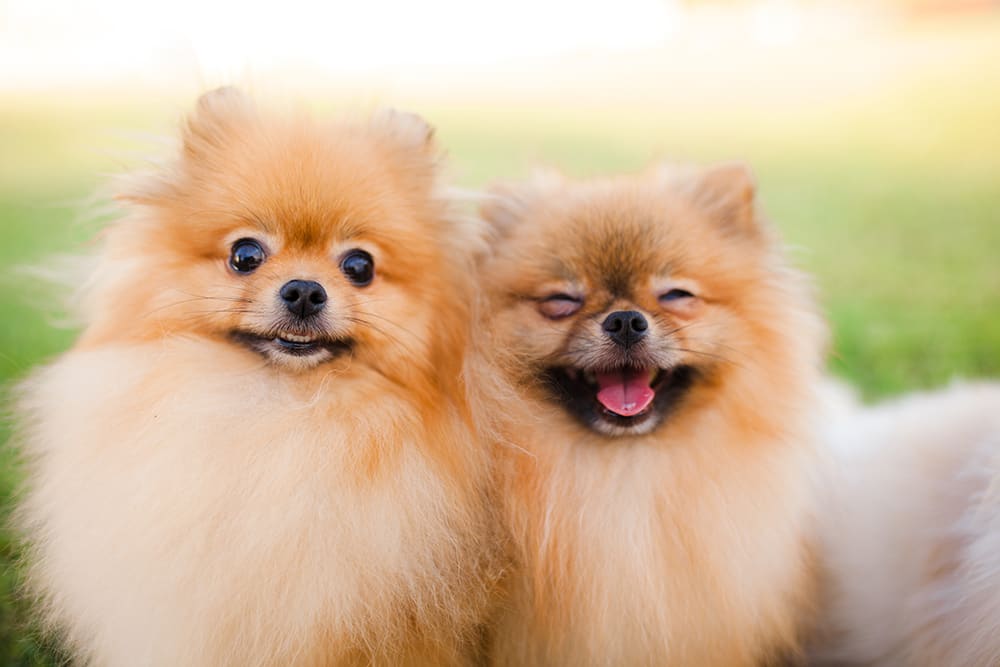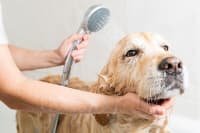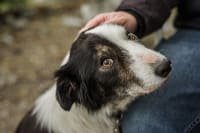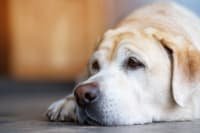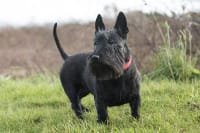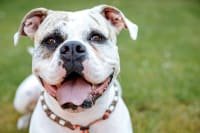Pet Care
Dog Grooming 101 – Grooming Different Coat Types
At-Home Dog Grooming & Profession Grooming Services
Ensuring that your dog’s coat and skin stay healthy requires regular care at home, and for many breeds, periodic trips to the groomer. In today’s blog post we discuss the grooming needs of dogs of different coat textures and lengths and provide advice on what can be done at home, and what should be done by a professional groomer.
Grooming Dog Breeds with a Double Coat
If your dog has a double coat it means that they have a soft layer of fur that provides warmth neatly tucked under a longer more coarse layer that protects them against sun and helps to repel moisture, dirt and parasites. When your weather begins getting warmer in the spring your dog will experience a dramatic shedding episode. This extreme shedding of the undercoat typically occurs once or twice a year.
Double-coated dogs can have long hair such as huskies and Pomeranians or short hair such as golden and labrador retrievers.
Long-haired double-coated dogs will need to be brushed 1 – 3 times each week to avoid matting and tangles that can lead to skin infections. You will also need to pay particular attention to the longer “feathers” of fur on your dog’s feet, legs, belly, bottom, and ears. It’s a good idea to trim those areas regularly since those areas are especially prone to matting.
Short-haired double-coated dogs require less regular brushing and trimming since matting tends not to be a problem for these breeds, however, like their long haired relatives, they will shed heavily once or twice a year.
Tips for Grooming Double-Coated Dogs:
- Do not shave double-coated dogs since a well groomed uncoat helps to regulate your dog’s body temperature even in the summer
- Use a shedding rake or FURminator to help remove excess undercoat during shedding episodes, or take your dog to the groomer for a professional brushing.
- Double-coated dogs typically do well with a full grooming session (including a bath) about 3-4 times a year depending on breed and lifestyle. Speak to your vet or groomer to find out how often your double-coated dog should be fully groomed.
Grooming Dogs With Silky Coats
Breeds such as Afghan hounds, Yorkshire terriers, and Irish setters have single-layer silky coats that grow continuously throughout the year and need regular care including haircuts. Grooming silky hair dogs is typically best left to professional groomers since matting can be an issue for these breeds.
Many owners of dogs with silky coats opt to have their dog’s hair cut short every 2-3 months but those who wish to keep their pup’s fur longer will need to have their dog groomed and trimmed every 4-6 weeks. Overbathing can lead to skin issues and dull coat so bathing is recommended on an as required basis or when recommended by your groomer.
Tips for Grooming Dogs with Silky Coats:
- Take your pup to a professional groomer every 2 – 3 months for expert care and haircuts
- Brush your dog gently and often. For some dogs (Irish setters and Afghan hounds included) daily brushing is recommended. Other silky coat dogs may be ok with brushing every other day or 4 times a week.
- You will need a brush with natural bristles, a bin pin brush, and a comb to keep your dog looking great between professional grooming sessions.
Grooming Dogs With Wiry Coats
Wiry coats are thick and bristly and feel coarse and rough to the touch. Often found on hunting breeds such as Schnauzers, Jack Russells and Terriers these coats offer dogs a layer of protection against pine needles, thorns and branches.
These coats are generally very low maintenance. Brushing once a week with a slicker brush, and a bath 4 times a year will typically keep these dogs looking and feeling great. Be sure not to overbathe your wiry haired dog since their hair is course and can be left dry and brittle with cleansed too often.
That said, because these breeds do not shed heavily they should have dead hairs removed. The best way to ensure these loose hairs are removed properly is to visit a professional groomer.
Tips for Grooming Dogs With Wiry Coats:
- Visit the groomer twice a year to have loose fur properly removed.
- Purchase a grooming knife to help remove loose fur at home.
- Bath these breeds as necessary, use products formulated for dogs with wiry fur.
Grooming Dogs With Curly & Wavy Coats
If your dog has curly or wavy fur they are one of the breeds most likely to suffer from matting and should be groomed regularly. To keep your dog’s coat looking great and their skin healthy your dog should be brushed several times a week. Daily gentle brushing can be a great way to bond with your dog while keeping their coat free from mats.
Professional grooming is highly recommended for these breeds in order to limit matting. Take your curly haired dog to the groomer about every 4-6 weeks for professional care.
Dogs with curly hair include poodles and many poodle-mix breeds, Portuguese water dogs, Cavalier King Charles Spaniels, and Chesapeake Bay retrievers.
Tips For Grooming Dogs With Curly & Wavy Coats
- If mats form do not attempt to remove them yourself, this can be painful for your dog. Visit your dog’s professional groomer for care.
- Use a rubber tipped pin brush regularly to prevent matting and keep your dog’s coat looking great between grooming sessions.
- Curly haired dogs typically need bathing frequently. Poodles should be bathed about every 3 weeks.
Benefits of Professional Dog Grooming
Professional groomers have the tools, products and training to care for dogs of different breeds, sizes, coat types and temperaments. Your groomer can provide your pup with expertly styled breed specific haircuts but can also provide other services to help keep your dog looking and feeling their very best.
Other services provided by most professional groomers include: ear cleaning, anal gland expression, and nail trims. Meaning they take care of the yucky stuff, saving you time and hassle.
These professionals are also trained to spot the signs of developing skin problems, parasites, and abnormalities on (or just under) your pups skin so that you can get the professional help your pup needs before conditions become more severe.
Learn More About Our Dog Grooming Services
Note: The advice provided in this post is intended for informational purposes and does not constitute medical advice regarding pets. For an accurate diagnosis of your pet’s condition, please make an appointment with your vet.
Want to learn more about professional dog grooming services in Clemmons? Contact Animal Hospital of Clemmons today book a grooming appointment for your four-legged friend.
Looking for a vet in
Clemmons?
We’re always accepting new patients, so contact our veterinary hospital today to book your pet’s first appointment.
Related Articles View All
Puppy Teething Tips for Pet Parents
Our Clemmons vets understand how trying it can be when your puppy starts teething. Teething pain often leads puppies to chew on things they shouldn’t – including your best shoes and furniture. Here are a few tips to help you and your puppy deal with your puppy’s teething.
What To Do About Your Dog’s Stinky Breath
Do you avoid getting close to your pup because their stinky breath is unbearable? Bad breath is common in dogs — especially in senior dogs — and can be a sign of a serious health issue. Our Clemmons vets explain some causes of dog bad breath and how you can help to treat or even prevent it.
Why should I enrol my pet in a Wellness Plan?
If your veterinary clinic offers Pet Wellness Plans you may be curious as to how these plans work and whether they are worth signing up for. Today, our Clemmons vets share 4 benefits to consider when deciding whether a Pet Wellness Plan is right for you and your pet.
Dog Acupuncture & The Conditions It Can Treat
Our Clemmons vets know that if your pet is suffering from a health issue you will want to do all you can to help them feel better. Pet acupuncture can be a noninvasive way to help improve your pet’s rehabilitation. Here’s a bit about how acupuncture for dogs works and when it can be used.

